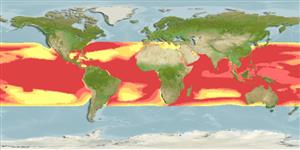分类 / Names
俗名 | 同种异名 | Catalog of Fishes(属, 种) | ITIS | CoL | WoRMS | Cloffa
Elasmobranchii
板鳃亚纲 (鲨鱼与 鱼) (sharks and rays) >
Carcharhiniformes (Ground sharks) >
Sphyrnidae (Hammerhead, bonnethead, or scoophead sharks)
Etymology: Sphyrna: Probable misspelling of sphyra (Gr.), hammer, referring to their hammer-shaped heads. (See ETYFish); mokarran: Arabic vernacular for this shark, described from the Red Sea, possibly from mogharn, horned, referring to the shape of its head. (See ETYFish).
More on author: Rüppell.
Environment: milieu / climate zone / depth range / distribution range
生态学
海洋; 半咸淡水; 海洋洄游的 (Ref. 51243); 深度上下限 1 - 300 m (Ref. 37816), usually 1 - 100 m (Ref. 89972). ; 40°N - 37°S, 180°W - 180°E
Circumglobal in coastal warm temperate and tropical seas (Ref. 13562). Western Atlantic: North Carolina, USA to Uruguay, including the Gulf of Mexico and Caribbean. Eastern Atlantic: Mediterranean and Morocco to Senegal. Indo-Pacific: throughout the Indian Ocean; Ryukyu Islands to New Caledonia and French Polynesia. Eastern Pacific: southern Baja California, Mexico to Peru. Highly migratory species.
Length at first maturity / 大小 / 重量 / 年龄
Maturity: Lm 249.5, range 210 - 300 cm
Max length : 610 cm TL 雄鱼/尚未辨别雌雄; (Ref. 244); common length : 370 cm TL 雄鱼/尚未辨别雌雄; (Ref. 13562); 最大体重: 449.5 kg (Ref. 40637); 最大年龄: 30 年 (Ref. 116211)
背棘 (总数): 0; 背的软条 (总数): 0; 臀棘 0; 臀鳍软条: 0. A very large hammerhead also with a notch at the center of the head (Ref. 5578). Front margin of head gently curved in juveniles, becoming nearly straight in adults, with slight median notch (Ref. 26938). 1st dorsal fin very high and curved; 2nd dorsal and pelvic fins high and with deeply concave rear margins. Light grey or grey-brown above, white below; fins without conspicuous markings (Ref. 5578).
A coastal-pelagic, semi-oceanic shark, found close inshore and well offshore, over the continental shelves, island terraces, and in passes and lagoons (Ref. 244, 58302). Often bottom and reef associated at 1-80 m (Ref. 58302). Prefers to feed on stingrays and other batoids, groupers and sea catfishes, but also preys on other small bony fishes, crabs, squid, other sharks, rays, and lobsters (Ref. 244, 13562, 1602). A viviparous species, with 13-42 of about 56 to 70 cm young in a litter (Ref. 26938, 1602). Potentially dangerous to people (Ref. 13562) but only few, if any, of the attacks on people can be definitely attributed to it because of the apparent difficulty of distinguishing large hammerhead species involved in attacks (Ref. 244). Caught occasionally by target shark longline, demersal tangle net and tuna gillnet fisheries (Ref.58048). Meat utilized for human consumption (fresh, fresh-frozen, dried-salted, and smoked), liver oil for vitamins, fins for soup, hides for leather, and carcasses for fishmeal (Ref. 244). Its large fins, including the tail, sail-like first dorsal fin, are prized in the Oriental sharkfin trade (Ref. 47737).
Life cycle and mating behavior
成熟度 | 繁殖 | 产卵场 | 卵 | 孕卵数 | 仔鱼
Viviparous with a yolk sac placenta and 13-42 young in a litter (Ref. 244); 6-42 pups after gestation period of ~11 months (Ref.58048). Size at birth between 50 to 70 cm TL (Ref.58048, Ref. 13562).
Compagno, L.J.V., 1984. FAO Species Catalogue. Vol. 4. Sharks of the world. An annotated and illustrated catalogue of shark species known to date. Part 2 - Carcharhiniformes. FAO Fish. Synop. 125(4/2):251-655. Rome: FAO. (Ref. 244)
世界自然保护联盟红皮书 (Ref. 130435)
极度濒危 (CR) (A2bd); Date assessed: 09 November 2018
人类利用
渔业: 商业性
更多信息
参考文献养殖养殖信息品种遗传学Electrophoreses遗传率疾病加工NutrientsMass conversion
工具
特别资料
下载 XML
网络资源
Estimates based on models
Preferred temperature (Ref.
123201): 21.3 - 28.9, mean 27.2 °C (based on 4410 cells).
Phylogenetic diversity index (Ref.
82804): PD
50 = 0.5029 [Uniqueness, from 0.5 = low to 2.0 = high].
Bayesian length-weight: a=0.00229 (0.00133 - 0.00396), b=3.10 (2.94 - 3.26), in cm total length, based on LWR estimates for this species & (Sub)family-body (Ref.
93245).
营养阶层 (Ref.
69278): 4.3 ±0.5 se; based on diet studies.
回复力 (Ref.
120179): 低的, 最小族群倍增时间4.5 - 14 年 (tmax=30; tm=8.2; Fec=13).
Fishing Vulnerability (Ref.
59153): Very high vulnerability (90 of 100).
Nutrients (Ref.
124155): Calcium = 6.09 [1.31, 34.08] mg/100g; Iron = 0.597 [0.148, 1.835] mg/100g; Protein = 20.7 [18.6, 22.9] %; Omega3 = 0.168 [0.066, 0.417] g/100g; Selenium = 33.5 [10.8, 93.8] μg/100g; VitaminA = 4.93 [1.58, 16.43] μg/100g; Zinc = 0.393 [0.195, 0.737] mg/100g (wet weight);
